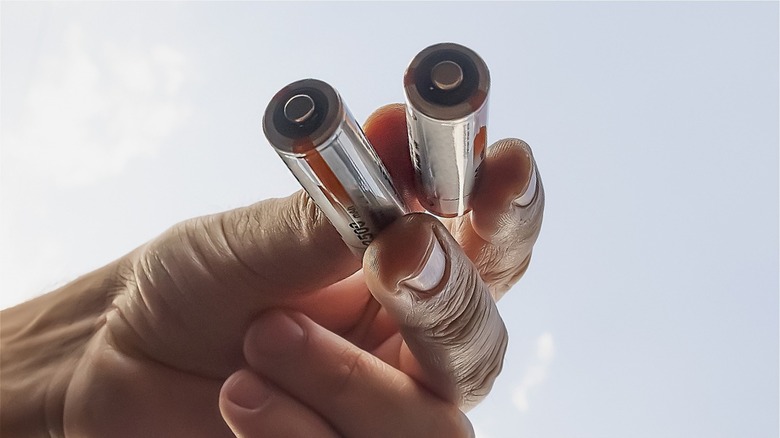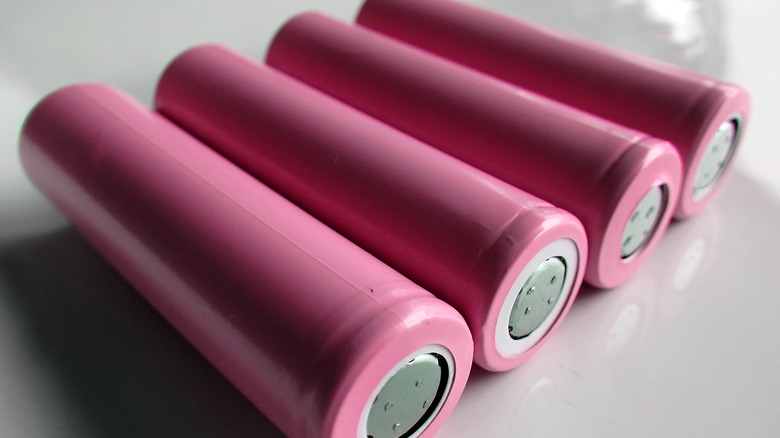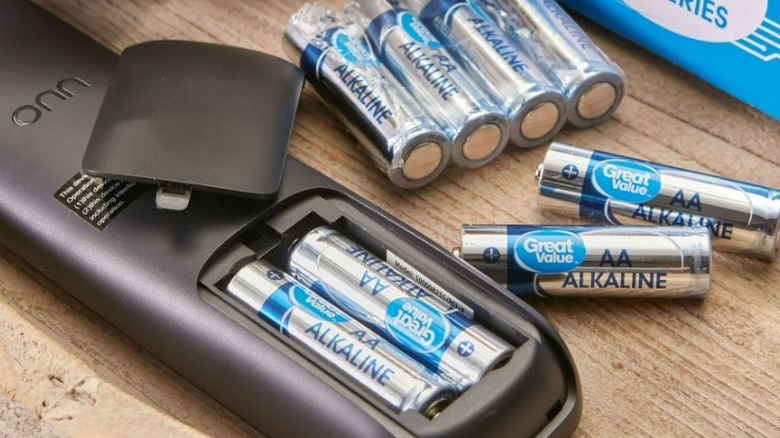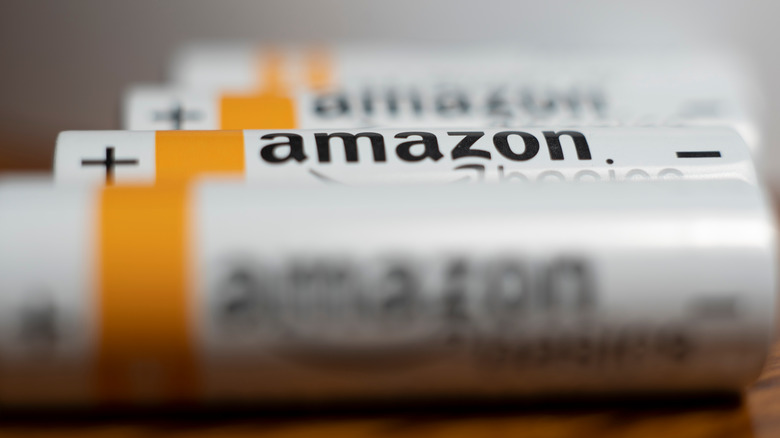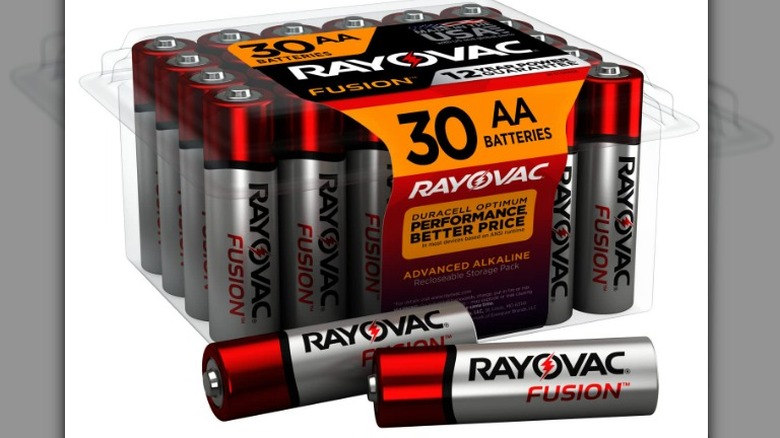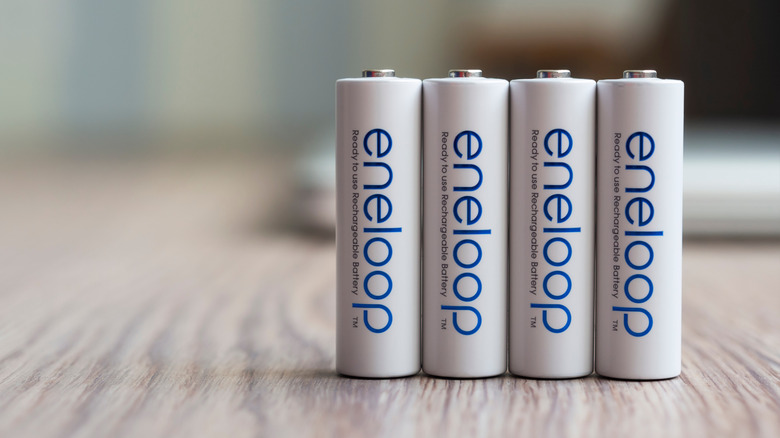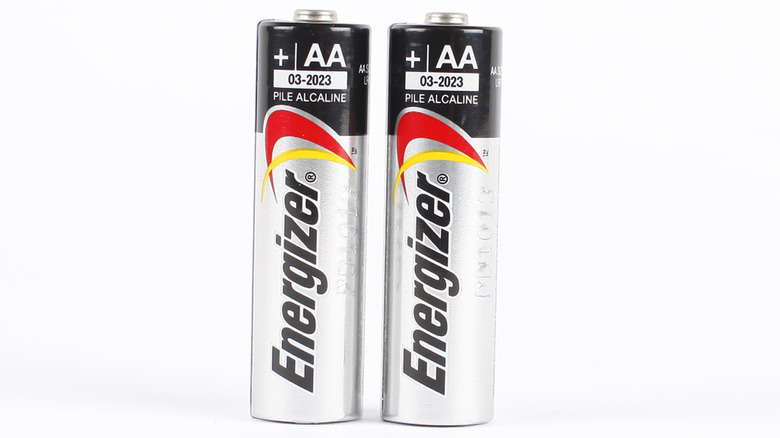Battery Brands Ranked From Worst To Best
There are so many battery options today that, even when you restrict your sights to AAs, it's almost impossible to untangle which are the best. We took a look at some of the biggest names in battery testing out there for public consumption today and ranked battery brands based on capacity, performance at various drain levels, temperature performance, weight, shelf life, their tendency to leak, and price.
Ranking brands is different from ranking batteries, of course, and it turns out to be a lot more complicated. You cannot necessarily trust that every battery made by one brand is automatically better than every comparable battery from any other given brand. We analyzed a metric ton of data and tried to make sense of which brands tend to do the best job. We combined our own efforts with data from Consumer Reports, Consumer NZ (a New Zealand publication), Gigazine (for power, capacity, and weight), Trailcam Pro (for cold weather performance), PowerStream (capacity), Wirecutter (for capacity after 50 charge cycles), and CinemaSound (for performance versus cost analysis) and others. We also looked at consumer reviews at Amazon, Lowe's, and Home Depot.
The worst battery brand is UltraFire
As wonderful as eBay is as a resource for just about anything, it can also be a frustrating source of counterfeit and fake products. Let's look at the sad case of UltraFire, a Chinese battery brand that has become so closely associated with poor quality (and dangerous) fakes that it's impossible to recommend.
False battery specs usually involve Ah ratings that are impossibly high, wildly exaggerated — or both. Consider the two UltraFire cells tested by Battery Bro. These were marked 4200 and 4900 mAh on their wrappers, but Ultrafire doesn't sell 18560 batteries claiming to have more capacity than 3400 mAh. (The maximum capacity for a 18650 Lithium-ion cell is generally considered to be 3500 mAh, and certainly no more than 3600). Occasionally, you might also find rechargeable cells that are actually worn-out older batteries re-wrapped and sold.
This is annoying, and maybe even fraudulent, but it's nothing compared to the other problem created by UltraFire and other counterfeits: the advertisement of cells as protected (with a circuit that prevents problems like over-discharge), when in fact they are not.
14500 Li-ion rechargeable battery brands
Strictly speaking, 14500 batteries and AAs aren't the same things. They are the same size and shape, or close to it, but 14500 Li-ions (roughly 14 mm in diameter by 50.0 mm in length) batteries have a nominal voltage of about 3.7v. AA Li-ion batteries, on the other hand, are normally 1.2v, and standard AA batteries are nominally 1.5v. So they're not interchangeable, and you'll break some things if you try to stick in a 14500 where an AA belongs. So why bring it up?
The 14500 is a whole class of batteries, and dozens of brands, that are either terrible or are counterfeited so frequently that attempting to buy one leaves you with a terrible battery. Those two things are functionally equivalent. Rather than listing a bunch of low-profile brands (like UltraFire) with the same set of problems, we're grouping these together as well. These rechargeables are often rated as high-drain with high (often fraudulently so) Ah capacity ratings.
They don't come close to the ratings, and they show incredibly steep capacity drop-offs even at the smallest loads. The names on this list might be familiar to anyone who's shopped for high-drain 18650 cells in the past, but all of these also produce batteries in the AA form factor. This list includes names like GTF, GTL, TrustFire, and Efest. Some of these companies make perfectly serviceable cells as well, and others appear to be prone to outright intentional misrepresentation, such as absurdly (and impossibly) inflated capacity ratings and advertised-but-missing features like protection circuits.
The missing protection circuits are a big deal because missing protection is one major cause of Lithium-ion batteries catching fire. This is why Amazon eventually banned the sale of 14500 and other cylindrical Li-ions outright.
Great Value
Most of the criticism we saw concerning batteries labeled with Walmart's house brand, Great Value, seemed to center around the fact that Costco's Kirkland batteries are better. There's not a lot of test data on Great Value batteries, but what we've seen shows Great Value AAs having sub-par performance at lower current draws. This holds until you get into the range of the average LED flashlight, around 1 to 1.5 amps, at which point the Walmart brand performs about average, and stays middle-of-the-pack for higher levels of drain. The highest-drain tests we referenced for Great Value were 3 amps, via Henrik K. Jensen. At about 1 amp, these batteries would provide about an hour of life.
Great Value alkaline AAs have discharge curves that indicate a pretty standard alkaline performance — if a little low on capacity. The typical alkaline battery shows a gentle but steady decline in capacity as amperage increases, which then sharply falls off toward zero capacity at high levels of drain.
Fuji and Fujitsu
Batteries branded Fujitsu and Fujifilm, often shortened to "Fuji" even on the company's branded products, are made by a company called FDK Group. This is the same company that makes some IKEA batteries, and FDK now owns the factories that used to make Sanyo batteries (usually labeled Panasonic, except for some reputable Li-ion cells in the 18650, 26500, and other offbeat sizes). So we're grouping Fuji and Fujitsu together not because of the name, but because they fell right next to each other in our rankings and turned out to be manufactured by the same company.
Fuji batteries were rated a little low on power by Gigazine. Of course, power and capacity aren't everything. CinemaSound rated the cost per hour for Fuji's EnviroMax AA at the highest of all alkaline batteries they tested, edging out the Duracell Procell.
Fujitsu is slightly more consistent in the sense that the battery brands we considered were almost all around the bottom of the pack, with the strange exception of the Fujitsu Universal Power AA. This battery has very low capacity at lower drains, but actually performs pretty well overall and tops the tests we reviewed for a 3-amp drain. Unfortunately, none of the other Fujitsu batteries tested had such an upside.
Kodak and Deleepow
Right around 35 years ago, Kodak partnered with Matsushita in order to stake a claim in the booming battery market. Today, its partner is a startup called Wildcat Discovery Technologies to produce leading-edge EV batteries. But all along the way, the consumer batteries branded by Kodak have suffered.
In an industry full of confusing product names, Kodak seems to be among the most determined to make discussion as bewildering as possible. We looked at four Kodak AAs: Extra Heavy Duty, Max, Super Heavy Duty, and Xtralife. The Carbon Zinc offerings (typically these have "heavy duty" somewhere in the name) are had even for Carbon Zinc. The Extra Heavy Duty's high cost and mediocre duration scores made it the worst CinemaSound tested for cost per hour.
Then there's Deleepow — which you probably haven't run across unless you've searched for this specific brand on Amazon. Based mostly on reviews from Wirecutter and Amazon, we'd have to advise you to keep moving if you're looking for a strong and reliable rechargeable AA.
Wirecutter found that Deleepow's rechargeable batteries' capacities were often rated far higher than the batteries' actual, measurable capacities. The worst was the NiMH AA, which is rated by Deleepow at 3300 mAh, at the top of what is possible with an AA, but only measured 58 percent of that at 1917 mAh. Deleepow's Lithium-ion AA also underperformed. Interestingly, the company's Lithium-ion AAA was measured at a higher capacity than its rating.
The soft middle: mid-range battery brands
A lot of batteries with mediocre performance are hard to find, and it's even harder to find hard data detailed enough to rank their quality. So, in this category we're grouping a number of products from (or branded by) Eveready, CVS, Home Depot, Amazon Basics, Impecca, PNP Depot, Polaroid, RadioShack, and Sunbeam. We will discuss a few factors that distinguished each. Keep in mind that these are not, on the whole, particularly bad batteries. The middle of the pack, especially with regard to alkaline batteries, is often perfectly acceptable.
Eveready's alkaline Gold received mid-range scores from PowerStream, but CinemaSound found its cost per hour to be pretty good, and New Zealand's Consumer site actually recommended the battery based on acceptable performance and energy scores. The Carbon Zinc Super Heavy Duty didn't fare as well. Inconsistencies plagued the mid-range batteries overall. Amazon Basics batteries, for example, scored quite high when they were of the NiMH rechargeable variety, but their alkaline units didn't do as well.
In the fashion of nonsense battery naming practices everywhere, Polaroid's Super alkaline outperformed its Extreme. On the other hand, Consumer Reports gave CVS Health AA Alkaline batteries a poor score, but somewhat predictably found CVS Health MAX AA Alkaline batteries recommendable. PNP Depot's Lithium rechargeable got poor reviews at Lowe's, but near-perfect ratings at Home Depot. The only consistency in the soft middle is inconsistency.
A whole gaggle of good 14500 Li-ion rechargeables
In spite of all we've said about counterfeit and recycled cells destroying the Lithium-ion 14500 landscape, there are quite a few good ones out there as well. The trouble comes when you realize that, in many ways, the older NiMH chemistry still outperforms Lithium-ion rechargeables. Still, we must acknowledge the good ones, and some of the more highly regarded brands in the Lithium-ion rechargeable battery space include Samsung, Sanyo/Panasonic (who also make good 1.2v Li-ion rechargeables), LG, Sony, Shockli, Keeppower, LiitoKala, AWT, Tensai, Windyfire and Efan.
That said, there are still a lot better batteries on the list — we're only just past the middle of the pack, as it were. If you see any brands you've never heard of before today any lower on the list than this, don't be too shocked — there are more than a few battery companies doing good work in small batches.
Tenergy and Ansmann
Tenergy might be better known for its chargers than for its batteries, but it turns out the company makes some high-quality NiMH rechargeable AAs. Wirecutter found the 800 mAh cell's capacity measured close to its advertised rate, and that the capacity remained high even after 50 charge cycles. Trailcam Pro tested some batteries' performance in cold temperatures, and found that the Tenergy Premium AA rechargeable maintained 86 percent of its room temperature capacity even down at 5 degrees Fahrenheit.
Next is German manufacturer Ansmann's batteries, which performed very well in independent testing. But you might have some difficulty finding them in a brick-and-mortar store. And they can be a little pricey. We charted data on two of their NiMH rechargeables (2500 and 2850 mAh). Both came close to their nominal capacity at .1 amps, and the 2850 mAh battery was one of the highest-capacity batteries we reviewed. Along with that high capacity, Jensen says, comes a high self-discharge rate, as detailed in the battery's datasheet. Jenson notes — with apparent surprise — that Ansmann publishes "real datasheets" for his batteries, an uncommon practice. Ansmann's alkaline also get good reviews on Amazon, managing 70 percent 5-star reviews on its 20-pack.
Rayovac and ACDelco
Rayovac always feels like a sort of legacy battery brand along the lines of Eveready, and probably would not have fared so well in our rankings but for the company's Fusion line, which enjoys a strong reputation among consumers and testers. Consumer Reports gave Fusion a high 85 rating, and reviews are overwhelmingly positive at Home Depot (4.8 stars), Lowe's (4.7 stars), and Amazon (4.6 stars). The Fusion models were rated as having a solid duration and moderate per-hour cost by CinemaSound. But based on tests of other Rayovac AAs, the company would be firmly in the middle of the pack without the Fusion line.
SlashGear readers likely recognize ACDelco as a manufacturer of auto-related products such as belts and, in particular, batteries. In fact, ACDelco is owned by General Motors. But the company also produces well-regarded AA batteries for general consumer use. There's not a lot of test data out there. In CinemaSound's study, ACDelco had the cheapest AA alkaline and the second cheapest battery overall, and was tops in the study's best value marks in spite of the fact that the batteries have mediocre duration in the two types of tests CinemaSound ran.
PKCell
PKCell's alkaline and zinc batteries are fairly ordinary, although their Carbon Zinc topped CinemaSound's tests with fan duration. PKCell Ultra Alkaline batteries fell just behind the zinc PKCell batteries in those tests, but both did far worse in the second round of testing against Saramonic UWmic9 wireless transmitters.
But it's the company's NiMH rechargeable batteries we're looking at here that really perform well in testing. Their 1300, 2200, and 2600 mAh batteries all easily matched those ratings and handled high loads well. While the 1300 mAh battery performed well, Jensen notes that 1300 mAh is a considerably low capacity for your average AA battery. On the other hand, the 2600 mAh battery (which tested at 2801 mAh) was at the top of the capacity rankings for all AA cells. Like many of the battery brands on this list, they might not look like much, but they got it where it counts.
Panasonic and Eneloop
This is another case of two batteries falling next to each other in our rankings and conveniently appearing to be more than just ships passing in the night: these batteries turn out to be made by the same company. (This is no secret. Lots of batteries are labeled "Panasonic Eneloop.) The other was Fujifilm and Fujitsu, and wouldn't you know it? FDK also used to make Eneloops. All of this inbreed... err, cross-pollination aside, Panasonic tends to make highly regarded batteries... although there are some exceptions.
In all, we looked at ratings, tests and reviews for 24 Panasonic and Eneloop batteries. There were some misses; Wirecutter rated Eneloop NiMH rechargeables poorly, and Jensen didn't have much love for a 2050 mAh Panasonic Evolta NiMH. Consumer.org.nz gave Panasonic's Extra Heavy Duty a "Don't Buy" rating, but gave it to all the other Carbon Zinc batteries as well. Otherwise, Panasonic cells did well across the boards, generally matching their capacity ratings and performing well.
Duracell and Kirkland
It's not going to surprise anyone that Duracell and Energizer are our top-ranked brands, but it was a little to see how large the gap was. The only dings the company took in our research was the less-than-stellar reputation of its NiMH rechargeables of all sorts — but these tend to suffer for every manufacturer, and as often as not this is either a misunderstanding by or the fault of the consumer.
It might still surprise a few people that Costco's own brand Kirkland makes a set of AA batteries that've appeared near the top of test results, not just for Consumer Reports but also among Henrik Jensen's tests. And it shouldn't surprise anyone that Kirkland batteries are made by Duracell.
Taking the two brands as one, there's a lot of variation in test results, but overall many more wins than losses. Duracell had three batteries (Duracell Coppertop Duralock AA Alkaline, Duracell Quantum AA Alkaline, and Kirkland Signature (Costco) AA Alkaline) at the top of Consumer Reports' last battery roundup, and two in Gigazine's as well. With the exception of the 1300 mAh Duralock rechargeables, the batteries performed well and met their rated capacities.
The best battery brand is Energizer
Energizer (who also makes Eveready) just edged out Duracell in our rankings, but they could easily have been reversed. (A couple of alkaline batteries with low (and possibly outdated) rankings from Consumer Reports made most of the difference, and the scores weren't that bad. Mostly, though, Energizer's products across the entire spectrum of AAs — from alkaline to Lithium-ion — tend to perform well.
For example, two Energizer batteries topped Consumer Reports' last Lithium-ion battery rankings. Energizer Ultimate Lithium batteries and NiMH Energizer Recharge batteries stood above and beyond the rest, while Energizer as a brand, as a whole, found their way to the top of the battery bunch.
Again, the top spot could as easily have gone to Duracell, as Duracell general alkaline AAs outperformed Energizer slightly. But overall, Energizer ended up being the most consistent and most impressive of the battery brands we examined that are available on the market today.
